Electrolux EWF1090 Manual [ms]
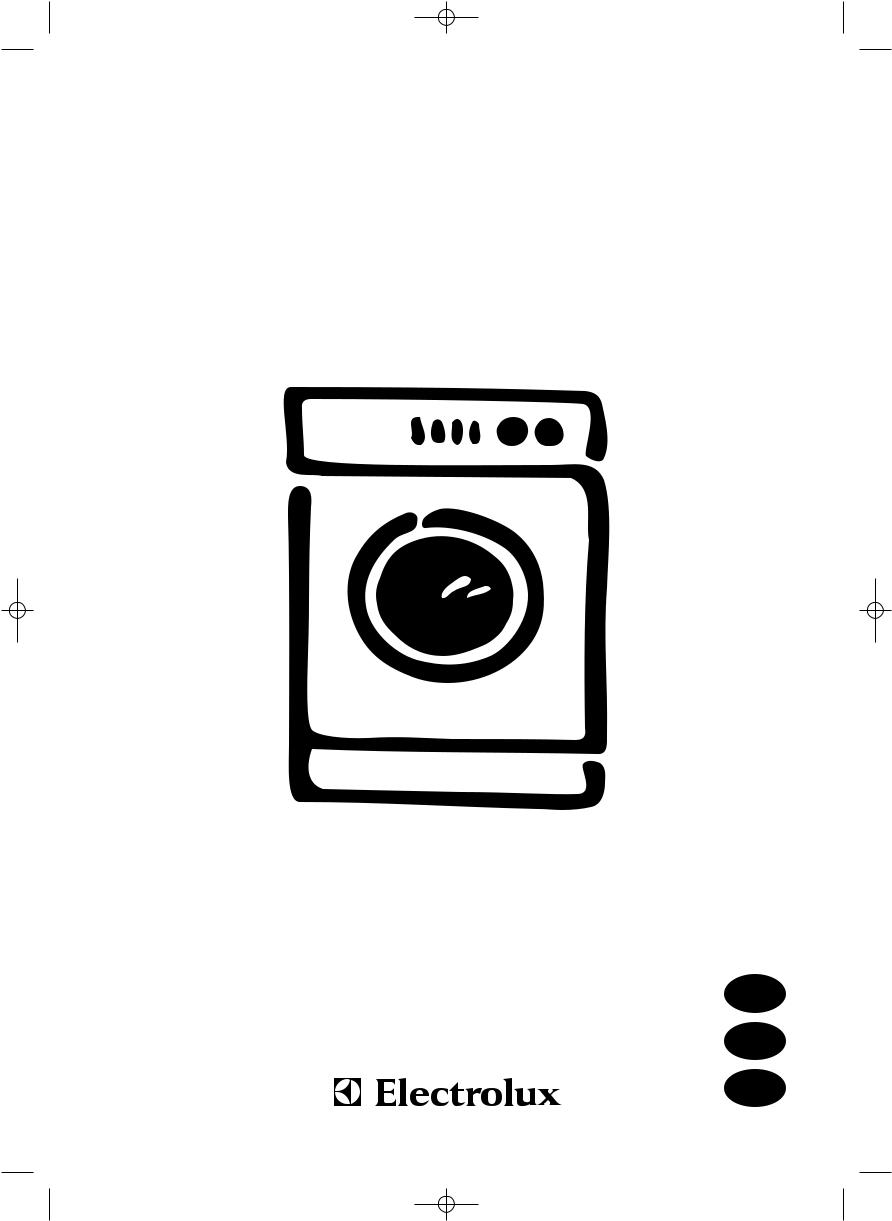
im_ewf1090_uk.qxd 07/09/2005 12:22 Pagina 1
WASHING MACHINE
INSTRUCTION BOOKLET
EWF 1090
GB
CN
MS
147 103 170
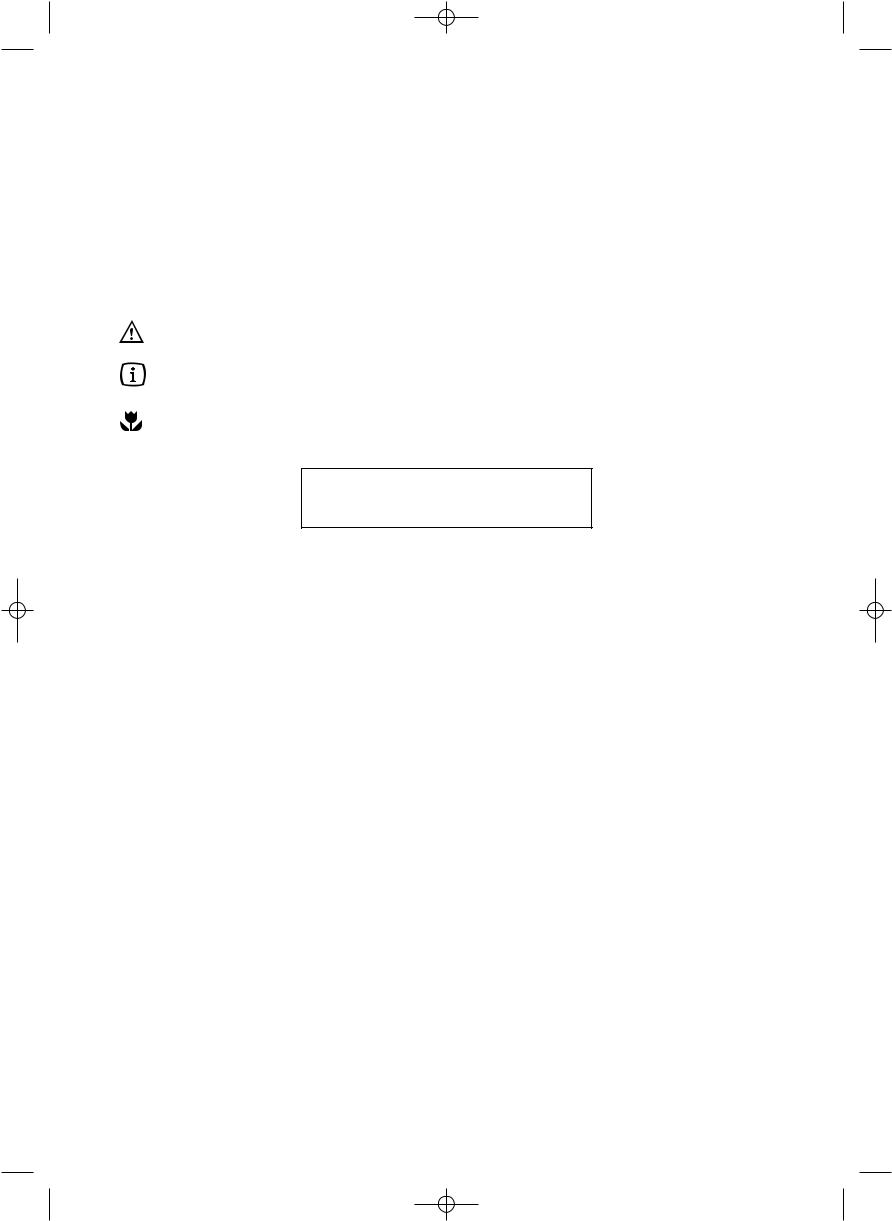
im_ewf1090_uk.qxd 07/09/2005 12:22 Pagina 2
Dear customer,
Please read these operating instructions carefully and pay particular attention to the safety notes indicated in the first pages. We recommend that you keep this instruction booklet for future reference and pass it on to any future owners.
Transport damages
When unpacking the appliance, check that it is not damaged. If in doubt, do not use it and contact the Service Centre.
The symbols you will see on some paragraphs of this booklet have the following meaning:
The warning triangle and/or the key words (Warning!, Caution!) emphasize information that is particularly important for your safety or correct functioning of the appliance.
The information marked with this symbol provides additional instructions and practical tips on the use of the appliance.
Tips and information about economical and ecological use of the machine are marked with this symbol.
Our contribution to the protection of the environment: we use environmentally friendly paper.
Contents
Warnings |
3 |
Disposal |
4 |
Tips for environmental protection 4
Sorting the laundry |
12 |
Temperatures |
12 |
Before loading the laundry |
12 |
Maximum loads |
12 |
Technical specifications |
4 |
Laundry weights |
12 |
|
Removing stains |
12 |
|||
Installation |
5 |
Detergents and additives |
13 |
|
Quantity of detergents to be used |
13 |
|||
Unpacking |
5 |
|||
Internationnal wash code symbols |
14 |
|||
Positioning |
5 |
|||
Operating sequence |
15-17 |
|||
Water inlet |
5 |
|||
Washing programmes |
18-19 |
|||
|
|
|||
Water drainage |
6 |
|
|
|
Electrical connection |
6 |
Maintenance |
20 |
|
Your new washing machine |
7 |
Bodywork |
20 |
|
Description of the appliance |
7 |
Door Seal |
20 |
|
Detergent dispenser drawer |
20 |
|||
Detergent dispenser drawer |
7 |
Drain pump |
20 |
|
Use |
8 |
Water inlet filter |
21 |
|
Emergency emptying out |
21 |
|||
Control panel |
8 |
|||
Frost precautions |
21 |
|||
Controls |
8-11 |
|||
|
|
|||
Washing hints |
12 |
Something not working? |
22-23 |
2

im_ewf1090_uk.qxd 07/09/2005 12:22 Pagina 3
 Warnings
Warnings
The following warnings are provided in the interests of overall safety. You must read them carefully before installing or using the appliance.
Installation
•All internal packing must be removed before using the appliance. Serious damage may be caused to the machine or adjacent furniture if the protective transit devices are not removed or are not completely removed. Refer to the relevant paragraph in the instruction book.
•Any electrical work required to install this appliance must be carried out by a qualified electrician.
•Any plumbing work required to install this appliance must be carried out by a qualified plumber.
•After having installed the machine, check that it is not standing on its electrical supply cable.
•If the appliance is placed on a carpeted floor, ensure that air can circulate freely between the feet and the floor.
Use
•This appliance is designed for domestic use. It must not be used for purposes other than those for which it was designed.
•Use only the recommended quantities of fabric softener. An excessive amount could damage the laundry.
•Leave the porthole door slightly ajar when the appliance is not in use. This preserves the door seal and prevents the formation of musty smells.
•Always check that water has emptied out before opening the door. If not, drain the water following the instructions in the instruction book.
•Always unplug the appliance and shut the water tap after use.
General safety
•Repairs to the machine must be carried out only by qualified personnel. Repairs carried out by inexperienced persons could cause serious danger. Contact your local Service Centre.
•Never pull the power supply cable to remove the plug from the socket; always take hold of the plug itself.
•During high temperature wash programmes the door glass may get hot. Do not touch it!
•Only wash fabrics which are designed to be machine washed. Follow the instructions on each garment label.
•Do not overload the appliance. Follow the instructions in the instruction book.
•Make sure that all pockets are empty. Objects such as coins, safety pins, pins and screws can cause extensive damage.
•Do not machine wash garments saturated with petroleum, methylated spirits, trichlorethylene, etc. If such fluids have been used to remove stains prior to washing, wait until they have completely evaporated from the fabric before placing garments in the appliance.
•Place small items such as socks, belts, etc. in a cloth bag or pillowcase to prevent them getting trapped between the drum and the tub.
Child safety
•Children are often not aware of how dangerous electrical appliances can be. When the machine is working, children should be carefully supervised and not be allowed to play with the appliance.
•The packaging components (e.g. plastic film, polystyrene) can be dangerous to children - danger of suffocation! Keep them out of children’s reach.
•Keep all detergents in a safe place out of children’s reach.
•When the appliance is to be scrapped, cut off the electrical supply cable and destroy the plug with the remaining cable. Disable the door catch in order to prevent children from becoming trapped inside while playing.
ENGLISH
3

im_ewf1090_uk.qxd 07/09/2005 12:22 Pagina 4
 Disposal
Disposal
Packaging materials
The materials marked with the symbol 
 are recyclable.
are recyclable.
>PE<=polyethylene >PS<=polystyrene >PP<=polypropylene
This means that they can be recycled by disposing of them properly in appropriate collection containers.
Machine
Use authorised disposal sites for your old appliance. Help to keep your country tidy!
 Tips for environmental protection
Tips for environmental protection
To save water, energy and to help protect the environment, we recommend that you follow these tips:
•Normally soiled laundry may be washed without prewashing in order to save detergent, water and time (the environment is protected too!).
•The machine works more economically if it is fully loaded.
•With adequate pre-treatment, stains and limited soiling can be removed; the laundry can then be washed at a lower temperature.
•Measure out detergent according to the water hardness, the degree of soiling and the quantity of laundry being washed.
Technical specifications
DIMENSIONS |
|
|
|
Height |
85 cm |
|
Width |
60 cm |
|
Depth |
60 cm |
MAXIMUM LOAD |
Cotton |
8 kg |
|
Synthetics |
3.5 kg |
|
Delicates |
3.5 kg |
|
Woollens |
2 kg |
|
Handwash |
2 kg |
|
Silk |
1 kg |
SPIN SPEED max |
|
1000 rpm |
POWER SUPPLY VOLTAGE/FREQUANCY |
230-240V / 50HZ |
|
TOTAL POWER ABSORBED |
|
2200W |
MINIMUM FUSE PROTECTION |
|
10A |
WATER PRESSURE |
Minimum |
50kPa |
|
Maximum |
800kPa |
This appliance complies with the following EEC Directives: 73/23/EEC of 19/02/73 relating to low voltage
89/336/EEC of 03/05/89 relating to electromagnetic compatibility.
4
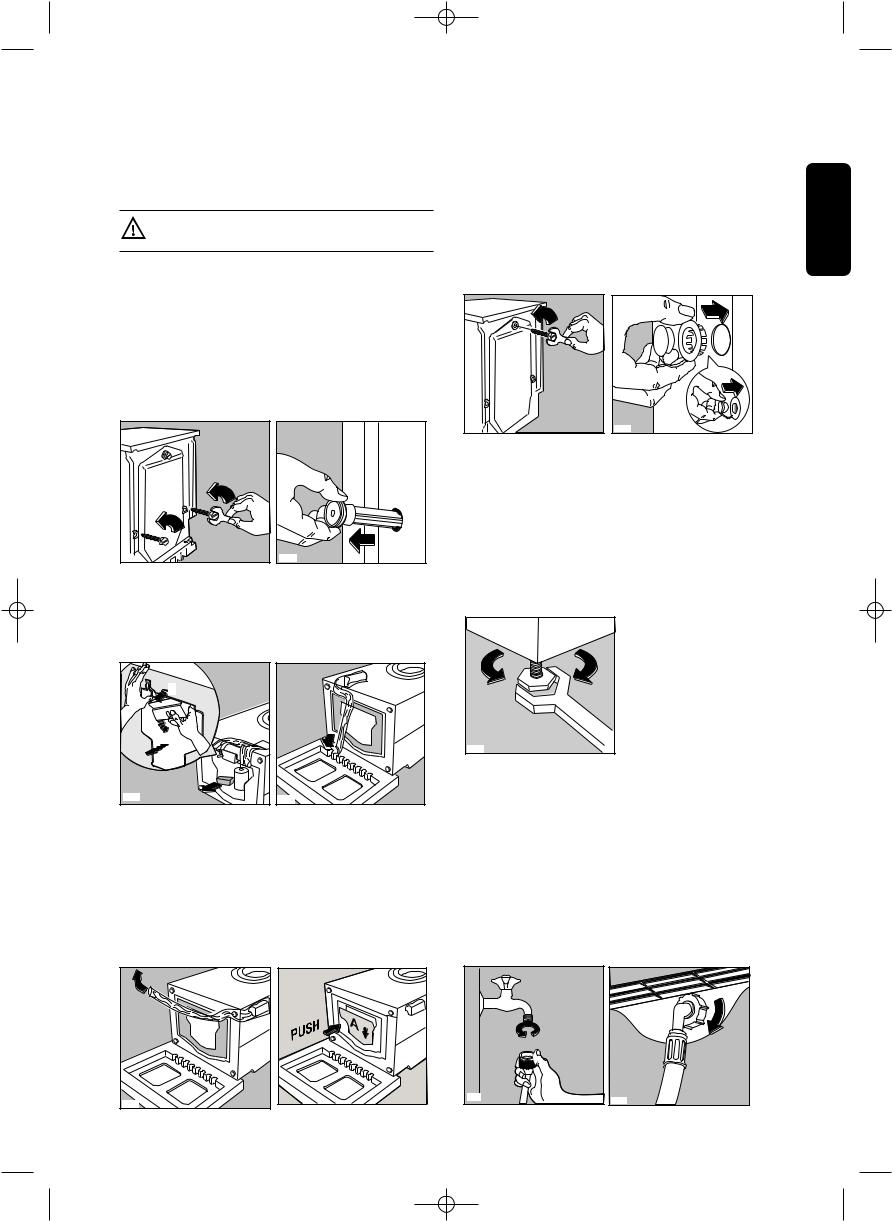
im_ewf1090_uk.qxd 07/09/2005 12:22 Pagina 5
Installation
Unpacking
All transit bolts and packing must be removed before using the appliance.
You are advised to keep all transit devices so that they can be refitted if the machine ever has to be transported again.
1.Using a spanner, unscrew and remove the two rear bottom screws. Slide out the two plastic pins. Lay the machine on its back, taking care not to squash the hoses. This can be avoided by placing one of the corner packing pieces between the machine and the floor
P1129 |
P0001 |
2.Remove the polystyrene block(s) from the bottom of the machine and release the two plastic bags.
3.Very carefully slide out the left polythene bag, removing it towards the right and then downwards.
1 |
2 |
3 |
P1123 |
P1126 |
4.Very carefully slide out the right polythene bag, removing it towards the left and then upwards. Remove the bottom cover placed into the drum of your appliance, lay it’s hook as the arrow ’A’ indicates and push the top of the cover to seal it closed
Important: You can find more detailed instructions regarding the bottom cover assembling in it’s relative bag.
P1127 |
5.Set the machine upright and remove the remaining rear screw. Slide out the relevant pin.
6.Plug all the holes with the plugs which you will find in the envolope containing the instruction manual.
P1128 |
P0002 |
Positioning |
|
Install the machine on a flat hard floor.
Make sure that air circulation around the machine is not impeded by carpets, rugs etc. Check that the machine does not touch the wall or cupboard units. Carefully level by screwing the adjustable feet in or out. Never place cardboard, wood or similar materials under the machine to compensate for any unevenness in the floor.
P1051 |
Water inlet
Connect the water inlet hose to a tap with 3/4” BSP thread.
Use the hose supplied with the washing machine. DO NOT USE OLD HOSES.
The other end of the inlet hose which connects to the machine can be turned in any direction. Simply loosen the fitting, rotate the hose and retighten the fitting, making sure there are no water leaks.
P1088 |
P0021 |
ENGLISH
5

im_ewf1090_uk.qxd 07/09/2005 12:22 Pagina 6
The inlet hose must not be lengthened. If it is too short and you do not wish to move the tap, you will have to purchase a new, longer hose specially designed for this type of use.
Water drainage
The end of the drain hose can be positioned in three ways:
Hooked over the edge of a sink using the plastic hose guide supplied with the machine. In this case, make sure the end cannot come unhooked when the machine is emptying.
This could be done by tying it to the tap with a piece of string or attaching it to the wall.
P0022 |
In a sink drain pipe branch. This branch must be above the trap so that the bend is at least 60 cm above the ground.
Directly into a drain pipe at a height of not less than 60 cm and not more than 90 cm.
The end of the drain hose must always be ventilated, i.e. the inside diameter of the drain pipe must be larger than the outside diameter of the drain hose.
The drain hose must not be kinked. Run it along the floor; only the part near the drainage point must be raised.
P0023 |
For the correct functioning of the machine the drain hose must remain hooked on the proper support piece situated on the top part of back side of the a[ppliance
Electrical connection
This machine is designed to operate on a 230-240 V, single-phase, 50 Hz supply.
Check that your domestic electrical installation can take the maximum load required (2.05 kW), also taking into account any other appliances in use.
Connect the machine to an earthed socket.
The manufacturer declines any responsibility for damage or injury through failure to comply with the above safety precaution.
Should the appliance power supply cable need to be replaced, this must be carried out by our Service Centre.
The appliance is supplied with a 13amp plug fitted. In the event of having to change the fuse in the plug supplied, a 13amp ASTA approved (BS1363/A) fuse must be used.
Should the plug need to be replaced for any reason, proceed as described below.
The wires in the mains lead are coloured in accordance with the following code:
Green and Yellow |
- Earth |
Blue |
- Neutral |
Brown |
- Live |
The wire coloured green and yellow must be
GREEN & YELLOW
E
|
13 A |
N |
L |
|

 BROWN
BROWN
BLUE
P1041 |
CORD CLAMP |
|
connected to the terminal marked with the letter «E» or by the earth symbol  or coloured green and yellow.
or coloured green and yellow.
The wire coloured blue must be connected to the terminal marked «N» or coloured black.
The wire coloured brown must be connected to the terminal marked «L» or coloured red.
Upon completion there must be no cut, or stray strands of wire present and the cord clamp must be secure over the outer sheath.
6
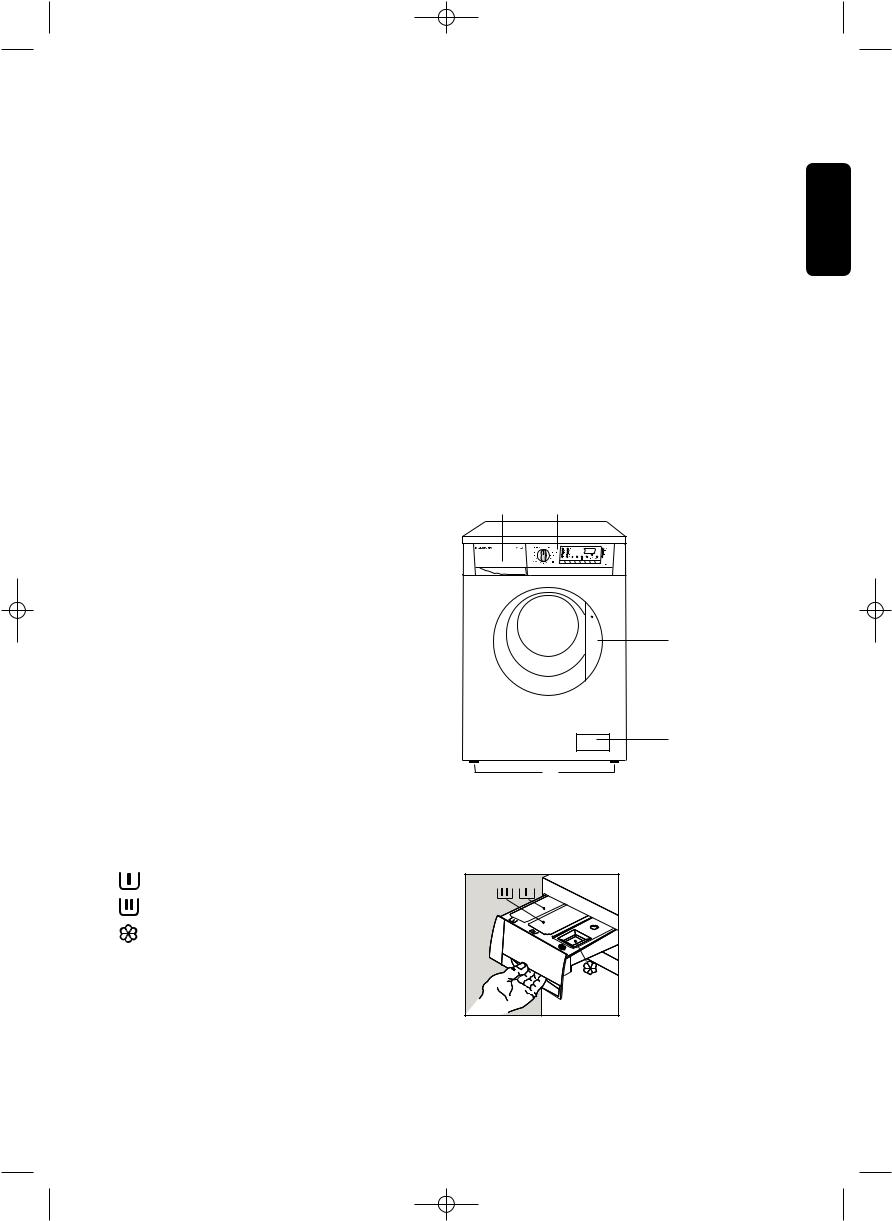
im_ewf1090_uk.qxd 07/09/2005 12:22 Pagina 7
Your new washing machine
This new machine, which is fitted with the New Jet System, meets all modern requirements for effective treatment of laundry with low water, energy and detergent consumption.
•The special Handwash programme with its new delicate wash system treats your delicate items with extreme care.
•The special wool programme with its new delicate wash system treats your woollens with extreme care.
•The automatic cooling of the washing water from 90° to 60°C before draining will prevent old drain pipes from being deformed.
•The balance control device ensures the machine is stable during the spin.
Description of the appliance
1. |
Detergent dispenser drawer |
1 |
2 |
|
|
||
2. |
Control panel |
|
|
3. |
Door handle |
|
|
4. |
Drain pump |
|
|
5. |
Adjustable feet |
|
|
3
4
5
Detergent dispenser drawer
Pre-wash
Main wash
Fabric softener, starch
ENGLISH
7
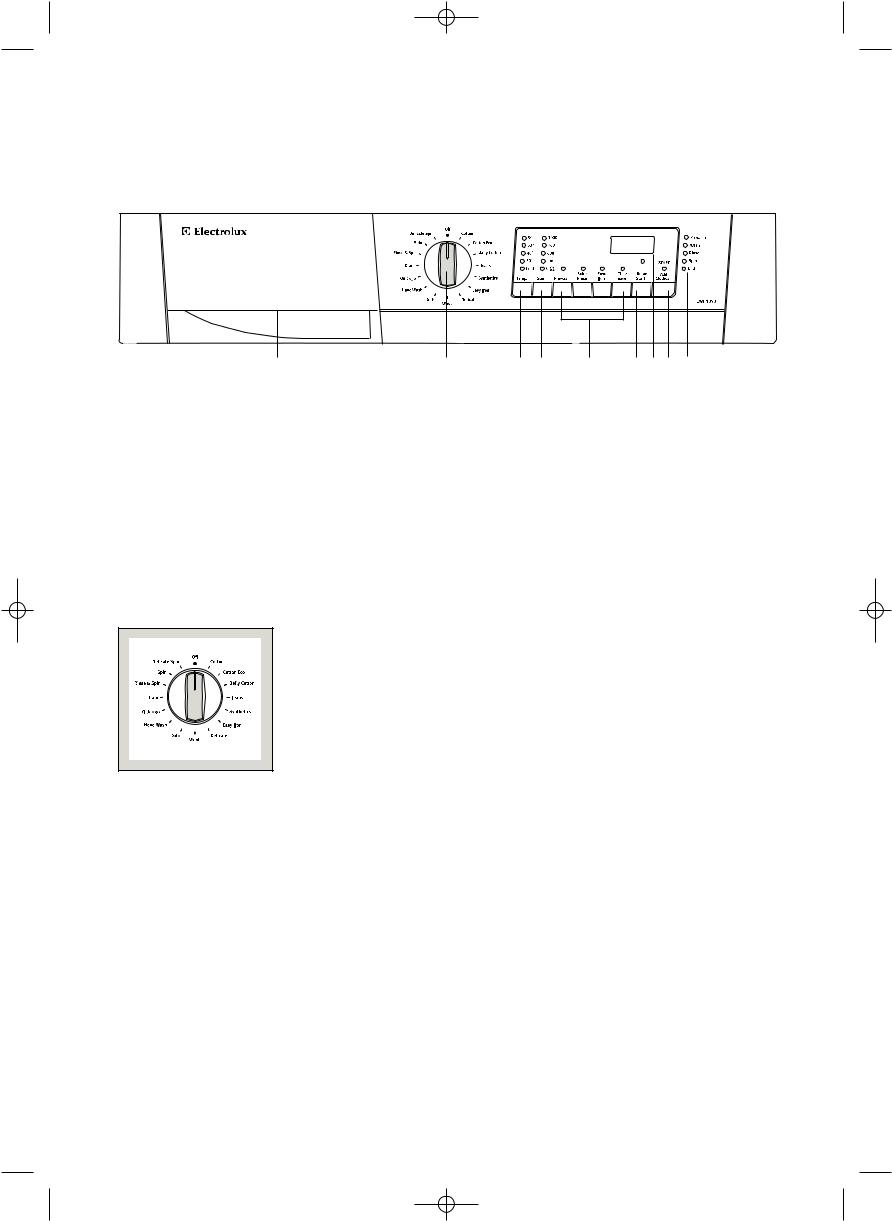
im_ewf1090_uk.qxd 07/09/2005 12:22 Pagina 8
Use
Control panel
1 |
2 |
3 |
4 |
5 |
6 7 8 |
9 |
1.Detergent Dispenser Drawer
2.Programme selector dial
The programme selector dial is divided into 3sectios:
1.Cotton, Cotton Eco, Daily Cotton (Green section)
2.Jeans, Synthetics, Easy iron, Delicates, Wool, Silk, Hand Wash, Quick30 (Blue section)
3.Drain, Rinse & Spin, Spin, Delicate Spin
(grey section)
The selector dial can be turned eighter clockwise or anti-clockwise. Position “Daily Cotton” corresponds to an energy saving programme for cotton and to “Off ” to reset programme or switching OFF the machine. At the end of programme, the selector dial must be turned to position “Off ” to switch the machine OFF.
4. Spin Speed button “Spin”
Press this button repeatedly to change the spin speed, if you want your laundry to be spin at a speed different from the one proposed by the washing machine and the relevent LED will light up.
Maximum speeds for EWF 1090 are:
for cotton: 1000 rpm
for wool, synthetic and handwashed fabrics 900 rpm.
for delicate, silk fabrics and mini programme:700 rpm
By pressing the Spin speed button you can also choose No Spin option. 
No Spin option  : when you choose this option, the machine will drain the water of the last rinse, and eliment the spin phase.To spin the Laundry, select spin or delicate spin programme.
: when you choose this option, the machine will drain the water of the last rinse, and eliment the spin phase.To spin the Laundry, select spin or delicate spin programme.
Select the desired spin speed by pressing this button and press Start/ Add Clothes button.
3. Temperature button “Temp.”
Press this button repeatedly to increase or decrease the temperature, if you want your laundry to be washed at a temperature different from the one proposed by the washing machine.
Maximum temperatures are 90°C for cotton, 60°C for synthetic fabrics, 40°C for delicate fabrics, wool and fabrics to be hand-washed, 30°C for silk and Quick 30 programme.
8

im_ewf1090_uk.qxd 07/09/2005 12:22 Pagina 9
5. Options Button
Depending on the programme, different functions can be combined. These must be selected after choosing the desired programme and before pressing the “Start / Add Clothes” button.
When these buttons are pressed, the corresponding LED will light up. When they are pressed again, the corresponding LED goes out.
If an incorrect option is selected, the LED flashes for about 2 seconds and the message Err is displayed. Press these buttons to select the following options:
1.Prewash: Select this option if you wish your laundry to be prewashed before the main wash (not available for wool ,handwash ,mini programme and silk programmes.)
The Prewash ends with a short spin at 650 rpm in programmes for cotton and synthetic fabrics, whereas in the programme for delicate fabrics the water is only drained.
2.Extra Rinse: This option can be selected with all programmes, except the wool and handwash programme. The machine will add 2 rinses for cottons and 1 rinse for synthetics, delicates and silk programme.This option is recommended for people who are allergic to detergents, and in areas where the water is very soft.
3.Easy Iron: Selecting this option the laundry is gently washed and spun to avoid any creasing in this way ironing is easier.
4.Time Save: This option can be used for lightly soiled (not for wool, hand wash, silk and miniprogramme) in order to obtain a good washing programme in a short time. The washing time will be reduced according to the type of fabric and the selected temperature.
6. Delay start Button
The wash programme can be delayed from 30 min - 60 min - 90 min, 2 hours and then by 1 hour up to a maximum of 23 hours by means of this button.
Selecting the Delay Start
•Select the programme and the required options.
•Select the delay start.
•Press “Start / Add Clothes” button: the machine starts its hourly countdown.
The programme will start after the selected delay has expired.
Delay Start cannot be used with “Drain”, “Spin” or “Delicate spin”.
Cancelling the delayed start
•Press “Start / Add Clothes” button.
•Press “Start / Add Clothes” button until “0’” is displayed.
•Press “Start / Add Clothes” button again.
ENGLISH
9

im_ewf1090_uk.qxd 07/09/2005 12:22 Pagina 10
7. Display
The display shows the following information:
Duration of the programme - Delayed start - Incorrect option selection - Alarm code - End of programme.
Duration of the selected programme
After selecting a programme, the duration is displayed in hours and minutes ( for example 2.05).
The duration is calculated automatically on the basis of the maximum recommended load for each type of fabric.
After the programme has started, the time remaining is updated every minute
Delayed start
The selected delay (23 hours max) set by means of the relevant button appears on the display for 3 seconds, then the duration of the previously selected programme is displayed.
The countdown is updated every hour and for the last 2 hours it is updated for each 30 min.
Incorrect option selection
If an option which is not compatible with the set wash programme is selected, the message Err is displayed for 2 seconds.
Alarm codes
In the event of operating problems, some alarm codes can be displayed, for example E20 (see paragraph “Something not working”).
End of programme
When the programme has finished a flashing zero is displayed.
10
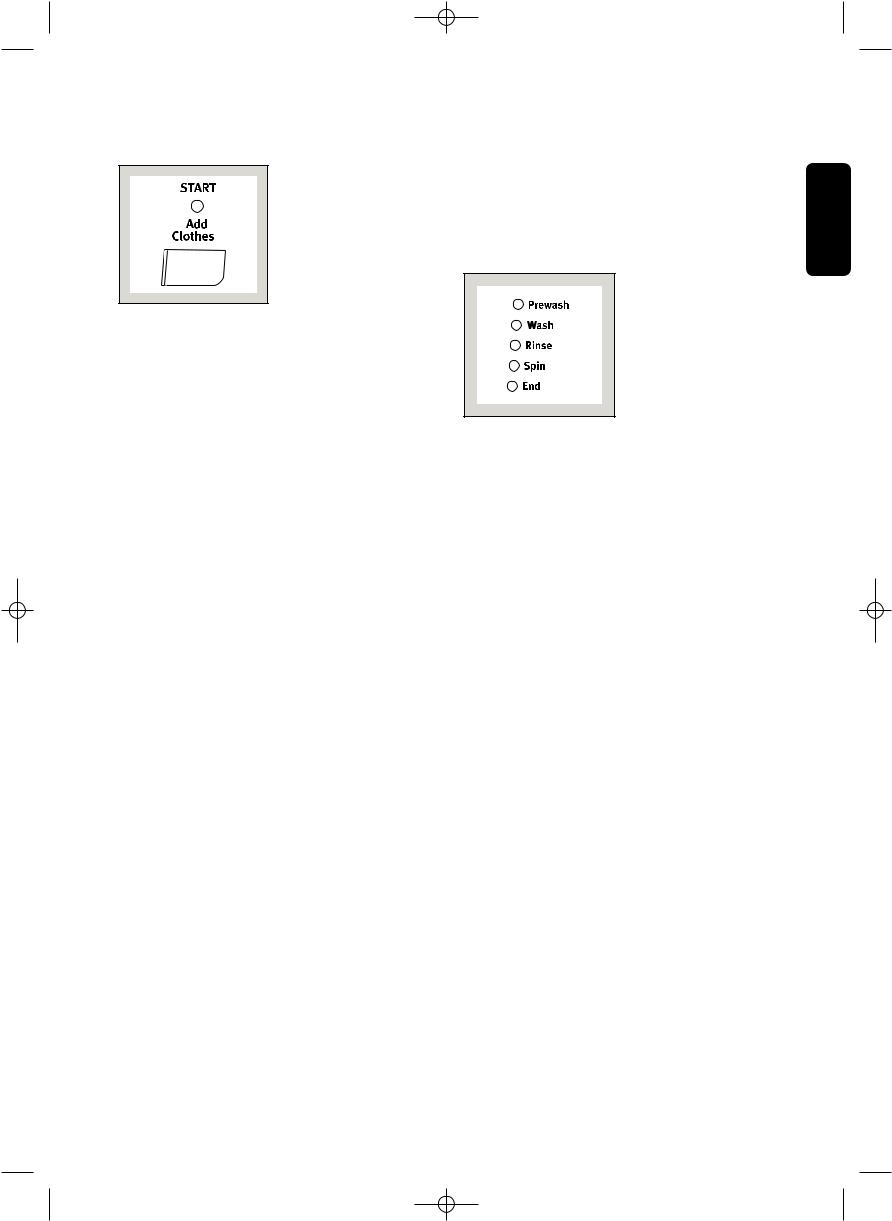
im_ewf1090_uk.qxd 07/09/2005 12:22 Pagina 11
8. Start/ Add Clothes Button
This button has 2 functions:
Start:
after you have selected the desired programme and options, press this button to start the washing machine. The light close to the button will stop flashing and remain lit.If you have selected a delay time option, the countdown will begin and will be shown on the display.
Add Clothes:
When you press this button again, the programme in progress is interrupted. The light close to the button will start flashing. To restart the programme, press the button again. When you press “Add Clothes”, it becomes possible to open the door if:
The washing machine is not in the heating phase;
The level of the water is not high;
The drum is not turning.
Important! You must pause the washing machine
before you make any change in the programme in
progress, by pressing “START/ Add Clothes” button.
9.Programme Phase indicator Light
By selecting the wash programme, the LED corresponding to the various phases making up the programme lights.
After you have started the programme, only the LED relevant to the phase that is currently being carried out will remain lit.
At the end of the programme the “End” LED illuminates.
The “End” LED flashes in the event of operating problems. And the relative alarm code appears on the display.
E10 |
= the machine does not fill |
E20 |
= the machine does not empty |
E40 |
= the door has not been closed |
To eliminate the problem, see paragraph “Something not working”.
ENGLISH
11

im_ewf1090_uk.qxd 07/09/2005 12:22 Pagina 12
 Washing hints
Washing hints
Sorting the laundry
Follow the wash code symbols on each garment label and the manufacturer’s washing instructions. Sort the laundry as follows:
whites, coloureds, synthetics, delicates, woollens.
Temperatures
90°-95° for normally soiled white cottons and linen (e.g. tea cloths, towels, tablecloths, sheets...)
50°-60° for normally soiled, colour fast garments (e.g. shirts, night dresses, pyjamas....) in linen, cotton or synthetic fibres and for lightly soiled white cotton (e.g. underwear).
O (cold) for delicate items (e.g. net curtains), mixed 30°-40° laundry including synthetic fibres and
woollens bearing the label «pure new wool, machine washable, non-shrink».
Before loading the laundry
Never wash whites and coloureds together. Whites may lose their “whiteness” in the wash.
New coloured items may run in the first wash; they should therefore be washed separately the first time.
Make sure that no metal objects are left in the laundry (e.g. hair clips, safety pins, pins).
Button up pillowcases, close zip fasteners, hooks and poppers. Tie any belts or long tapes.
Remove persistent stains before washing. Rub particularly soiled areas with a special detergent or detergent paste.
Treat curtains with special care. Remove hooks or tie them up in a bag or net.
Maximum loads
Recommended loads are indicated in the programme charts.
General rules:
Cotton, linen: drum full but not too tightly packed;
Synthetics: drum no more than half full;
Delicate fabrics and woollens: drum no more than one third full.
Washing a maximum load makes the most efficient use of water and energy.
For heavily soiled laundry, reduce the load size.
Laundry weights
The following weights are indicative: |
|
bathrobe |
1200 g |
napkin |
100 g |
quilt cover |
700 g |
sheet |
500 g |
pillow case |
200 g |
tablecloth |
250 g |
towels |
200 g |
tea cloth |
100 g |
night dress |
200 g |
ladies’ briefs |
100 g |
man’s work shirt |
600 g |
man’s shirt |
200 g |
man’s pyjamas |
500 g |
blouse |
100 g |
men’s underpants |
100 g |
Removing stains
Stubborn stains may not be removed by just water and detergent. It is therefore advisable to treat them prior to washing.
Blood: treat fresh stains with cold water. For dried stains, soak overnight in water with a special detergent then rub in the soap and water.
Oil based paint: moisten with benzine stain remover, lay the garment on a soft cloth and dab the stain; treat several times.
Dried grease stains: moisten with turpentine, lay the garment on a soft surface and dab the stain with the fingertips and a cotton cloth.
Rust: oxalic acid dissolved in hot water or a rust removing product used cold. Be careful with rust stains which are not recent since the cellulose structure will already have been damaged and the fabric tends to hole.
Mould stains: treat with bleach, rinse well (whites and fast coloureds only).
Grass: soap lightly and treat with bleach (whites and fast coloureds only).
Ball point pen and glue: moisten with acetone (*), lay the garment on a soft cloth and dab the stain.
Lipstick: moisten with acetone as above, then treat stains with methylated spirits. Remove any residual marks from white fabrics with bleach.
Red wine: soak in water and detergent, rinse and treat with acetic or citric acid, then rinse. Treat any residual marks with bleach.

im_ewf1090_uk.qxd 07/09/2005 12:22 Pagina 13
Ink: depending on the type of ink, moisten the fabric first with acetone (*), then with acetic acid; treat any residual marks on white fabrics with bleach and then rinse thoroughly.
Tar stains: first treat with stain remover, methylated spirits or benzine, then rub with detergent paste.
(*) do not use acetone on artificial silk.
Detergents and additives
Good washing results also depend on the choice of detergent and use of the correct quantities to avoid waste and protect the environment. Although biodegradable, detergents contain substances which, in large quantities, can upset the delicate balance of nature.
The choice of detergent will depend on the type of fabric (delicates, woollens, cottons, etc.), the colour, washing temperature and degree of soiling.
All commonly available washing machine detergents may be used in this appliance:
–powder detergents for all types of fabric,
–powder detergents for delicate fabrics (60°C max) and woollens,
–liquid detergents, preferably for low temperature wash programmes (60°C max) for all types of fabric, or special for woollens only.
The detergent and any additives must be placed in the appropriate compartments of the dispenser drawer before starting the wash programme.
If using concentrated powder or liquid detergents, a programme without prewash must be selected.
The washing machine incorporates a recirculation system which allows an optimal use of the concentrated detergent.
Pour liquid detergent into the dispenser drawer compartment marked  just before starting the programme.
just before starting the programme.
Any fabric softener or starching additives must be poured into the compartment marked  before starting the wash programme.
before starting the wash programme.
Follow the product manufacturer’s recommendations on quantities to use and do not exceed the «MAX» mark in the detergent dispenser drawer.
Quantity of detergent to be used
The type and quantity of detergent will depend on the type of fabric, load size, degree of soiling and hardness of the water used.
Water hardness is classified in so-called “degrees” of hardness. Information on hardness of the water in your area can be obtained from the relevant water supply company, or from your local authority.
Follow the product manufacturers’ instructions on quantities to use.
Use less detergent if:
–you are washing a small load,
–the laundry is lightly soiled,
–large amounts of foam form during washing.
ENGLISH
!
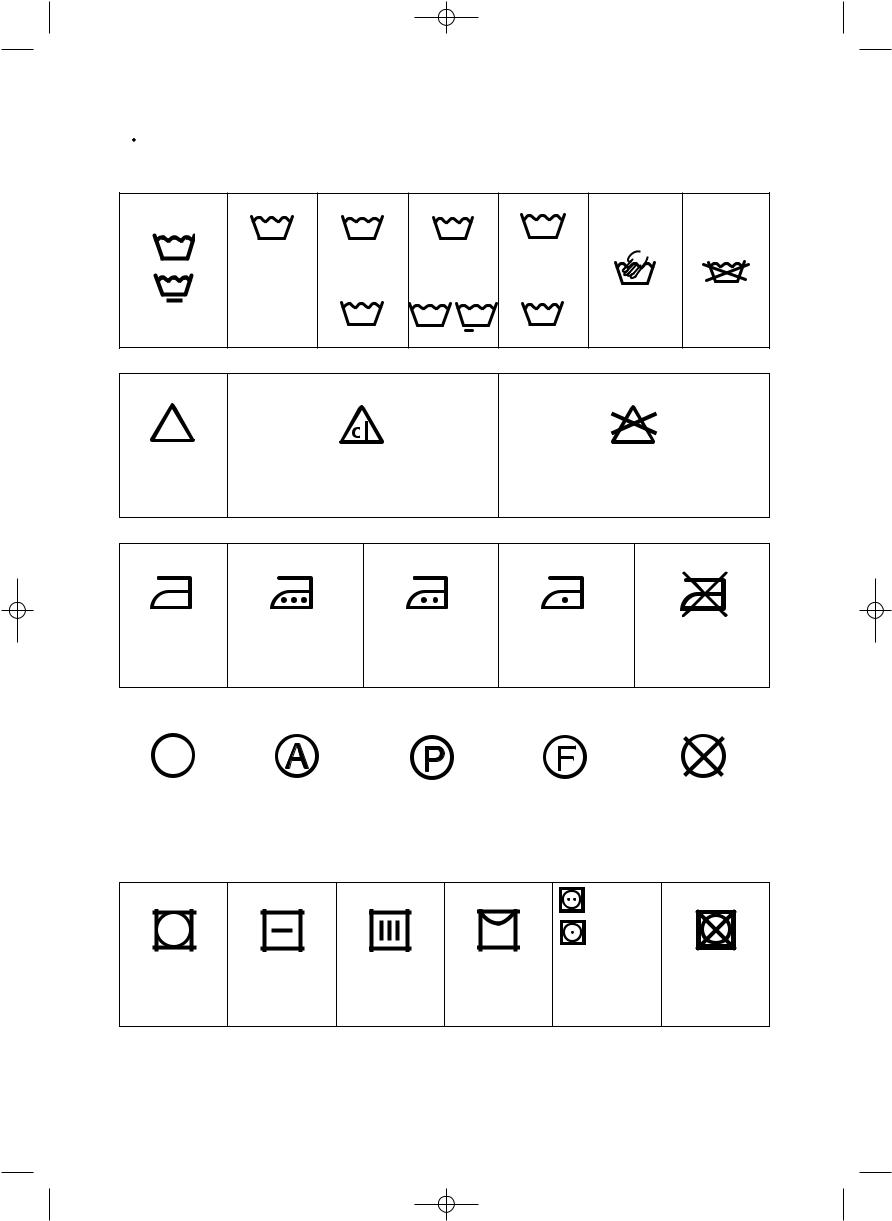
im_ewf1090_uk.qxd 07/09/2005 12:22 Pagina 14
 International wash code symbols
International wash code symbols
These symbols appear on fabric labels, in order to help you choose the best way to treat your laundry.
Energetic wash |
|
|
|
30 |
|
|
95 |
60 |
|
40 |
|
|
|
Max. wash |
Max. wash |
Max. wash |
Max. wash |
|
|
|
temperature |
temperature |
temperature |
temperature |
|
|
|
95°C |
60°C |
|
40°C |
30°C |
|
|
Delicate wash |
60 |
40 |
40 |
30 |
Hand wash |
Do not |
|
wash |
|||||
|
|
|
|
|
|
at all |
Bleaching |
Bleach in cold water |
Do not bleach |
Ironing |
Hot iron |
Warm iron |
Lukewarm iron |
Do not iron |
|
max 200°C |
max 150°C |
max 110°C |
|
Dry cleaning |
|
|
|
|
|
|
|
|
|
|
|
|
|
|
|
|
|
|
|
|
|
|
|
|
|
|
|
|
|
|
|
|
|
|
|
Dry cleaning |
Dry cleaning in |
Dry cleaning |
Do not |
|||||
|
in all solvents |
perchlorethylene, |
in petrol, |
dry clean |
||||
|
|
petrol, pure alcohol, |
pure alcohol |
|
||||
|
|
R 111 & R 113 |
and R 113 |
|
||||
|
|
|
|
|
|
|
|
|
high |
temperature |
low |
temperature |
Drying |
Flat |
On the line |
On clothes |
Tumble dry |
Do not |
|
|
|
hanger |
|
tumble dry |
14
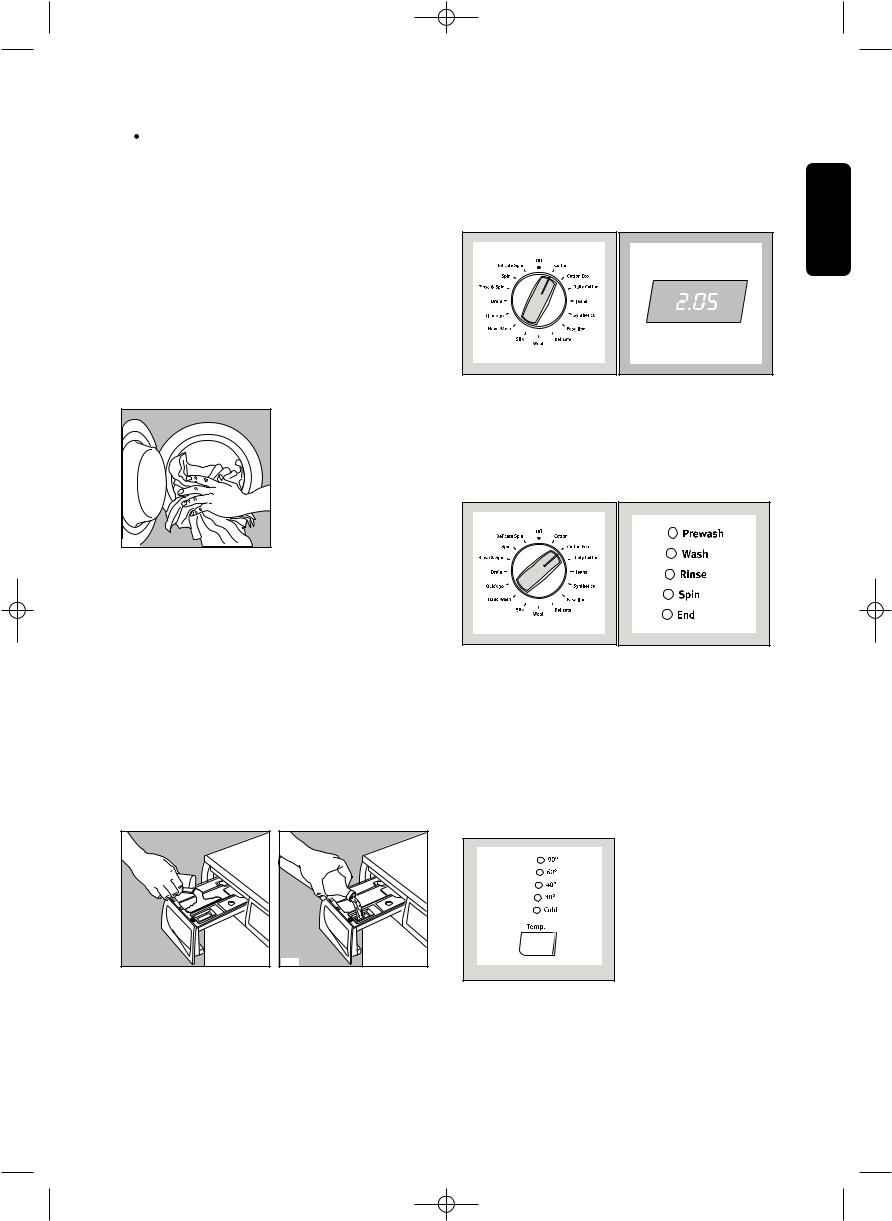
im_ewf1090_uk.qxd 07/09/2005 12:22 Pagina 15
 Operating sequence
Operating sequence
Before the first wash we recommend that you pour 2 litres of water into the main wash compartment  of the detergent drawer. Then run a cotton cycle at 60°C, with the machine empty, in order to remove any manufacturing residue from the drum and tub. Pour half a measure of detergent into the main wash compartment and start up the machine.
of the detergent drawer. Then run a cotton cycle at 60°C, with the machine empty, in order to remove any manufacturing residue from the drum and tub. Pour half a measure of detergent into the main wash compartment and start up the machine.
1. Place the laundry in the drum
Open the door.Place the laundry in the drum, one item at a time, shaking them out as much as possible.Close the door.
P0004
2. Measure out the detergent
Pull out the dispenser drawer until it stops. Measure out the amount of detergent recommended by the manufacturer in a graduated cup and pour it into the main wash compartment  .
.
If you wish to carry out the prewash or soak phase, pour detergent into the appropriate compartment marked  .
.
3. Measure out the additive
If required, pour fabric softener into the compartment marked  , without exceeding the «MAX» mark.
, without exceeding the «MAX» mark.
C0064 |
C0065 |
4.Switch the machine ON and OFF
Turn the selector dial to the desired programme to the switch appliance on.To switch the appliance off turn it to “Off”.
5.Select the desired programme
Turn the selector dial to the desired position: the LED corresponding to the different phases making up the selected programme illuminate.
The duration of the programme appears in the display.
6.Select the temperature
Press the “Temp.” button if you wish to select a temperature value different from the one proposed by the washing machine. The relevant LED will light up.
ENGLISH
#

im_ewf1090_uk.qxd 07/09/2005 12:22 Pagina 16
7. Select the spin speed or No Spin Option
Press the “Spin” button repeatedly, in order to select the desired spin speed or the No Spin  option. The
option. The
relevant LED will light up.
If you select the No Spin  option, the machine will stop at the end of the programme eliminating the spin phase.
option, the machine will stop at the end of the programme eliminating the spin phase.
EWF 1090
8. Select the desired option
Press the relevent button to select the required
options. Depending on the selected programm, only
certain options are avialable and shown during the
selection phase.
Note:Not all the options are compatible between themselves. The uncompatible option icons will disappear.
9.Select the Delay Start
Before you start the programme if you wish the starting to be delayed, press the Delay Start button. The figures corresponding to the selected delay will be displayed for about 3 seconds, after which the duration of the selected programme will appear on the display.
During this period it is possible to load other laundry:
•Press “Start/Add clothes” button;
•load the laundry;
•close the door and press “Start/Add clothes” button again.
10. Start the Programme
Press the “Start/Add clothes” button. The relevant LED will stop flashing. and only the LED relevant to the phase that is in progress will remain lit.
If you have chosen a delayed start, the washing machine will begin the countdown.
The display will show the duration of the programme or the selected delay.
11.How to change a programme during its cycle
You can alter the programme before it starts.
When the programme has started, you can only reset it by turning the programme selector dial to «Off» position and then you can select the new programme. Start it by pressing the “Start/Add clothes” button.
12.How to interupt a programme during its cycle
Press the “Start/Add clothes” button to interrupt a programme which is running, the corresponding LED starts to flash. Press the same button again to restart the programme.
$

im_ewf1090_uk.qxd 07/09/2005 12:22 Pagina 17
13. Cancelling a programme
Turn the selector dial to position «Off» to cancel a programme which is running. Now you can select a new programme.
14.How to open the door during the cycle of a programme
You can open the door, after having set the washing machine to PAUSE phase, by pressing “Start/Add clothes” button provided the following conditions exist:
1)the washing machine is not in the heating phase beyond 55°C
2)the level of the water is not high;
3)the drum is not turning.
After approximately 3 minutes, you can open the door.
Pay attention to the level and temperature of the water in the washing machine!
15. End of programme
The washing machine stops automatically at the end of the ptogramme giving an audible signal.
If the No Spin  option has been selected, the LED of the “Start/Add clothes” button goes off, the LED
option has been selected, the LED of the “Start/Add clothes” button goes off, the LED  and the “End” LED remain lit to indicate that the spin phase is eliminated.
and the “End” LED remain lit to indicate that the spin phase is eliminated.
To spin the laundry select the spin speed by means of the relevant button and then press the “Start/Add clothes” button. The laundry is spun at the selected spin speed.
Turn the programme selector dial to position «Off» to switch the machine off.
Remove the laundry from the washing machine. Check whether the drum is completely empty, by rotating it with your hand. The purpose of this is to prevent any items of laundry from remaining accidentally in the drum, where they might get damaged in a subsequent wash (e.g. by shrinking) or bleed colour into another load of laundry.
We advise you to close the water supply tap and disconnect the plug from the socket.
Leave the door ajar in order to air the washing machine.
ENGLISH
%
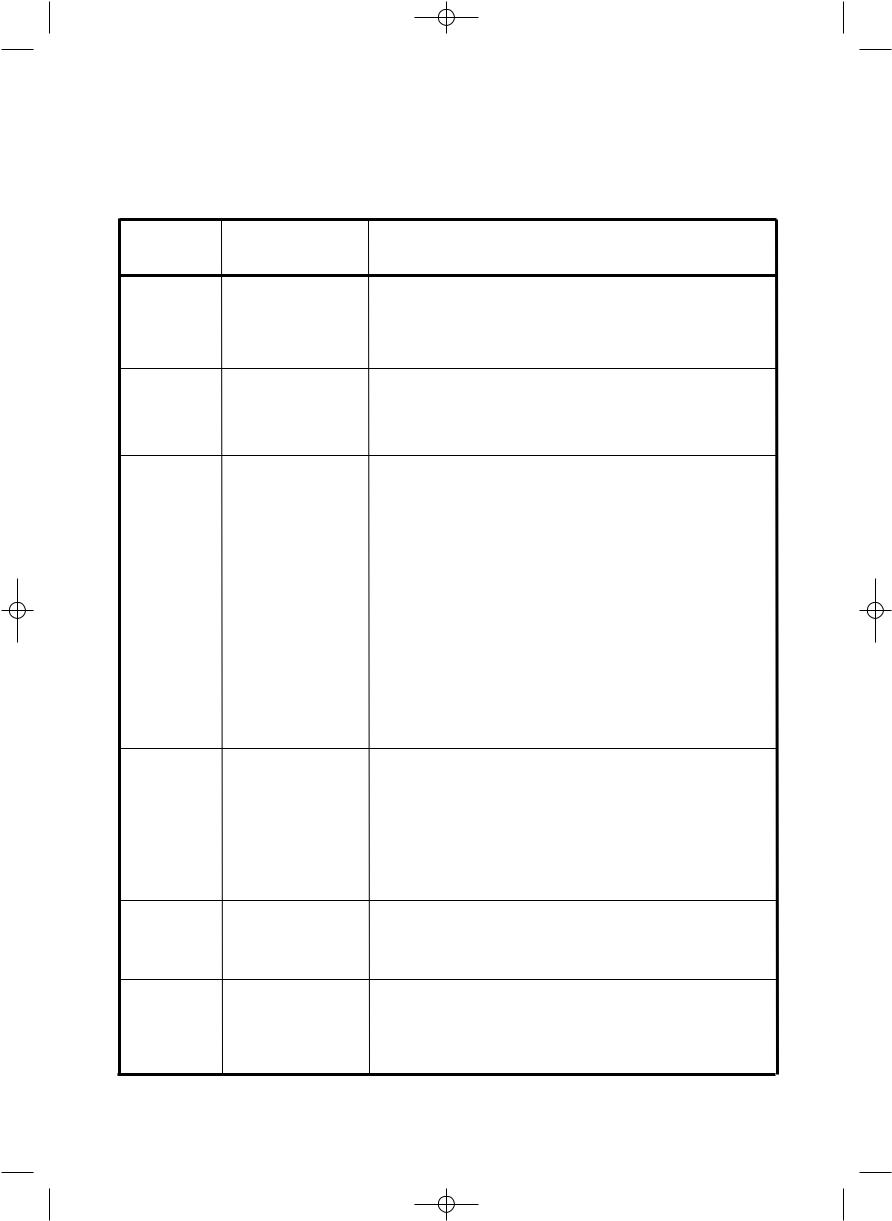
im_ewf1090_uk.qxd 07/09/2005 12:22 Pagina 18
Programme table
Washing Programmes
Wash |
Type of Laundry |
Description |
Available options |
Max. |
programmes |
|
of Programme |
|
Load |
Fabrics |
|
|
|
|
Cotton |
White and coloured |
Main wash |
Prewash |
8 kg |
|
cotton e.g Sheets, |
at 40°C-60°C |
Extra Rinse |
|
|
tablecloths, |
3 rinses |
Easy Iron |
|
|
household linen |
Long spin |
No Spin |
|
|
|
|
Time Save |
|
Cotton Eco |
Coloured cotton |
Main wash |
Prewash |
4.5 kg |
|
e.g. shirts, blouses, |
at 40°C-60°C |
Extra Rinse |
|
|
towels and |
3 rinses |
Easy Iron |
|
|
undergarments |
Long spin |
No Spin |
|
Daily Cotton* |
Economy wash for |
Main wash |
Prewash |
4.5 kg |
|
whites or fast coloured |
at Cold-60°C |
Extra Rinse |
|
|
cotton or linen fabrics, |
3 rinses |
Easy Iron |
|
|
normally soiled shirts |
Long spin |
No Spin |
|
|
|
|
|
|
Jeans |
Coloured cotton or |
Main wash |
Prewash |
8 kg |
|
linen fabric, normally |
at Cold-60°C |
Time Save |
|
|
soiled shirts, blouses |
3 rinses |
Extra Rinse |
|
|
|
Long spin |
No Spin |
|
|
|
|
Easy Iron. |
|
|
|
|
|
|
Synthetics |
Synthetics or mixed |
Main wash |
Prewash |
8 kg |
|
fabrice e.g lingerie, |
at Cold-40°C |
Time Save |
|
|
coloured garments |
3 rinses |
Extra Rinse |
|
|
|
Short spin |
No Spin. |
|
Easy Iron |
Synthetics and |
Main wash |
Prewash |
3.5 kg |
|
Delicates |
at Cold-60°C |
Extra Rinse |
|
|
|
3 rinses |
No Spin |
|
|
|
Short spin |
Time Save. |
|
|
|
|
|
|
Delicate |
Delicate fabrices, |
Main wash |
No Spin. |
3.5 kg |
|
e.g. acryllics, |
at Cold-40°C |
|
|
|
Polyester mixture |
3 rinses |
|
|
|
|
Short spin |
|
|
Wool |
Delicate fabrices, |
Main wash |
Extra Rinse |
2 kg |
|
Silk to be |
at 30°C |
No Spin. |
|
|
handwashed |
3 rinses |
|
|
|
|
Short spin |
|
|
Silk |
Clothes labelled |
Main wash |
No Spin |
1 kg |
|
“Pure new wool, |
at Cold-40°C |
|
|
|
non-shrink machine |
3 rinses |
|
|
|
washable” and silk |
Short spin |
|
|
|
fabric |
|
|
|
|
|
|
|
|
*This programme at 60c is the reference program for the energy label according to EEC directive 92/75
18

im_ewf1090_uk.qxd 07/09/2005 12:22 Pagina 19
Programme table
Special Programmes
Wash |
Type of Laundry |
Description |
Availble options |
Max. |
programmes |
|
of Programme |
|
Load |
Fabrics |
|
|
|
|
|
|
|
|
|
Hand Wash |
Special programme |
Main Wash |
No Spin |
2 kg |
|
for hand washing |
at 30°C |
|
|
|
fabrics. |
3 Rinses |
|
|
|
|
Short Spin |
|
|
|
|
|
|
|
Quick 30 |
Special Programme |
Main Wash |
No Spin |
4.5 kg |
|
for extremly delicate |
at 30°C-40°C |
|
|
|
items |
3 Rinses |
|
|
|
|
Short Spin |
|
|
|
|
|
|
|
Drain |
For Draining out |
Draning Of Water |
|
8 kg |
|
last rinse water in |
|
|
|
|
programmes with |
|
|
|
|
the rinse hold option |
|
|
|
|
|
|
|
|
Rinse & Spin |
Separate rinse cycle |
3 rinses with liquid |
No Spin |
8 kg |
|
for hand washed |
additive if required |
Easy Iron |
|
|
items of cotton |
long spin at |
Extra Rinse |
|
|
fabrics. |
maximum speed. |
|
|
Spin |
Seperate Spin |
Drain and Spin at |
|
8 kg |
|
for Cottons |
maximum speed |
|
|
|
|
|
|
|
Delicate Spin |
Seperate spin |
Short Spin |
|
3.5 kg |
|
for delicate items |
|
|
|
|
|
|
|
|
ENGLISH
19
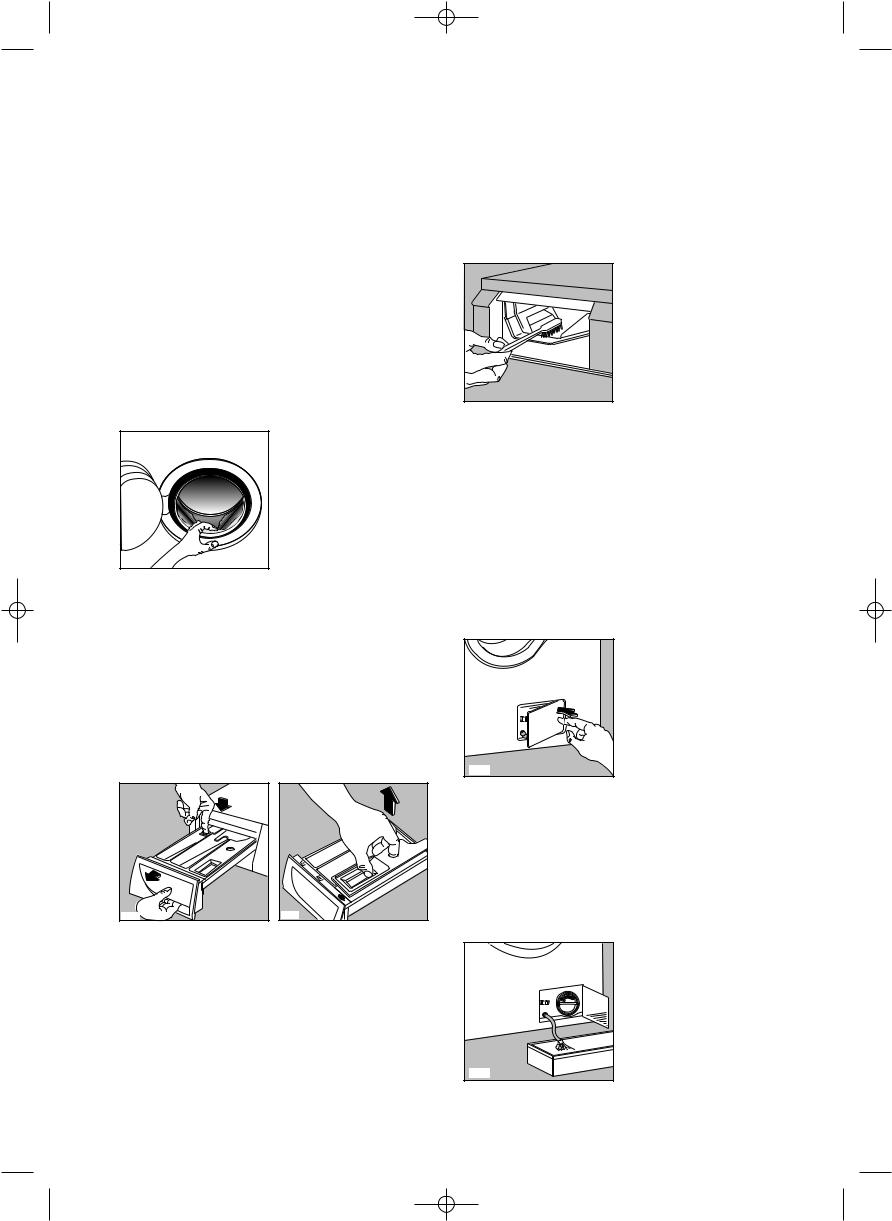
im_ewf1090_uk.qxd 07/09/2005 12:22 Pagina 20
Maintenance
1. Bodywork
Clean the outside of the machine with soap and water only. Rinse with clean water and dry with a soft cloth.
Important: do not use methylated spirits, solvents or similar products to clean the bodywork.
2. Door seal
Check from time to time the door seal and eliminate eventual possible objects that could be trapped in the fold.
Detergent can also accumulate inside the drawer recess: clean it with an old toothbrush. Refit the drawer after cleaning.
P0038 |
P1050
3. Detergent dispenser drawer
After a while, detergents and fabric softeners leave deposits in the drawer.
Clean the drawer from time to time by rinsing it under a running tap. To remove the drawer from the machine, press the button in the rear left-hand corner.
To facilitate cleaning, the top part of the additive compartments can be removed.
C0066 |
4. Drain pump
The pump should be inspected if
•the machine does not empty and/or spin
•the machine makes an unusual noise during draining due to objects such as safety pins, coins etc. blocking the pump.
Proceed as follows:
•Disconnect the appliance.
•If necessary wait until the water has cooled down.
•Open the pump door.
P1114 |
•Place a container close to the pump to collect any spillage.
•Release the emergency emptying hose, place it in the container and remove its cap.
•When no more water comes out, unscrew the pump cover and remove the pump. Always keep a rag nearby to dry up spillage of water when removing the pump.
P1115
20
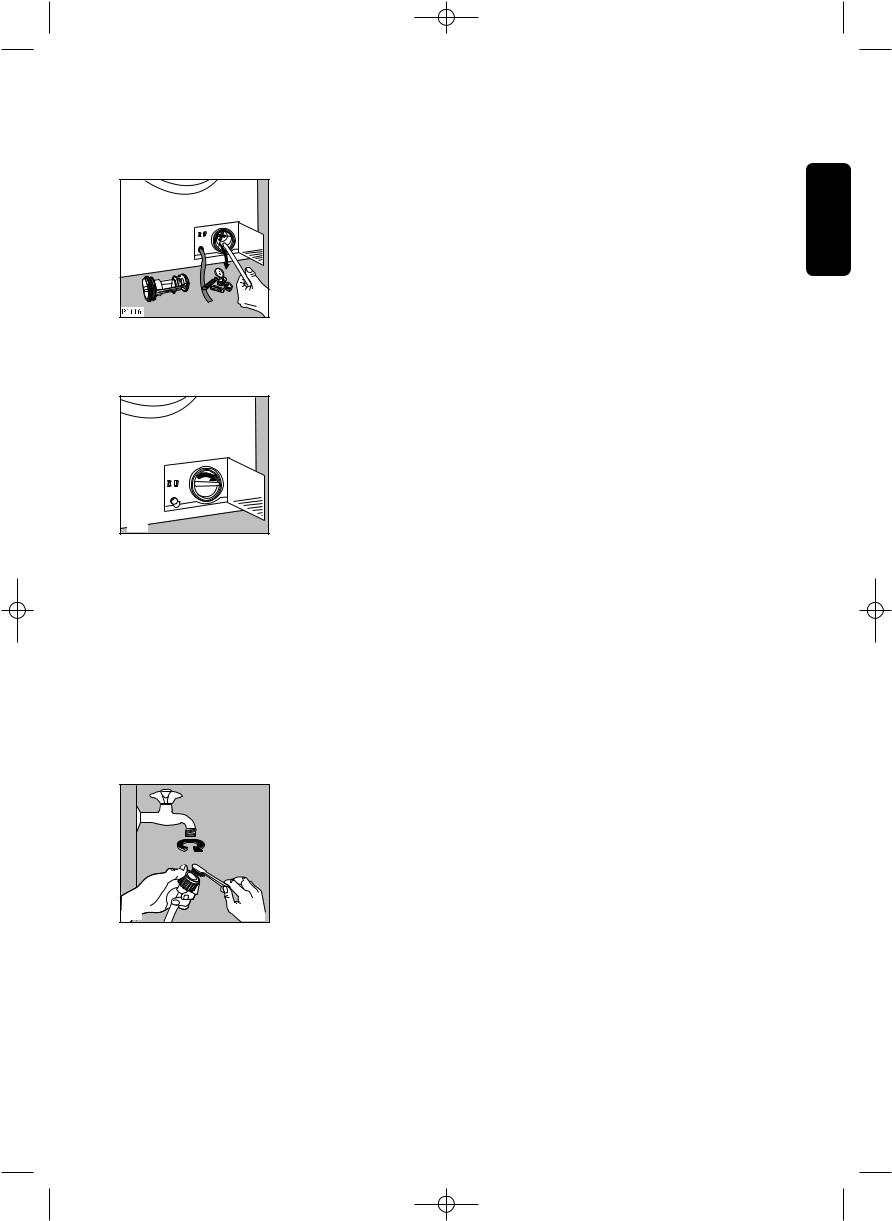
im_ewf1090_uk.qxd 07/09/2005 12:22 Pagina 21
•Remove any objects from the pump impeller by rotating it.
•Put the cap back on the emergency emptying hose and place the latter back in its seat.
P1117 |
•Screw the pump cover fully in.
•Close the pump door.
5. Water inlet filter
If you notice that the machine is taking longer to fill, check that the filter in the water inlet hose is not blocked.
Turn off the water tap.
Unscrew the hose from the tap.
Clean the filter with a stiff brush.
Screw the hose back onto the tap.
P1090 |
6. Emergency emptying out
If the water is not discharged, proceed as follows to empty out the machine:
•pull out the plug from the power socket;
•close the water tap;
•if necessary, wait until the water has cooled down;
•open the pump door;
•place a bowl on the floor and place the end of the emergency emptying hose into the bowl. Remove its cap. The water should drain by gravity into the bowl. Whe the bowl is full, put the cap back on the hose. Empty the bowl. Repeat the procedure until water stops flowing out;
•clean the pump if necessary as previously described;
•replace the emergency emptying hose in its seat after having plugged it;
•screw the pump cover again and close the door.
7. Frost precautions
If the machine is installed in a place where the temperature could drop below 0°C, proceed as follows:
•Remove the plug from the socket.
•Close the water tap and unscrew the water inlet hose from the tap.
•Place the end of the emergency emptying hose and that of the inlet hose in a bowl placed on the floor and let water drain out.
•Screw the water inlet hose back on and reposition the emergency emptying hose after having put the cap on again.
By doing this, any water remaining in the machine is removed, avoiding the formation of ice and, consequently, breakage of the affected parts.
When you use the machine again, make sure that the ambient temperature is above 0°C.
ENGLISH
21
